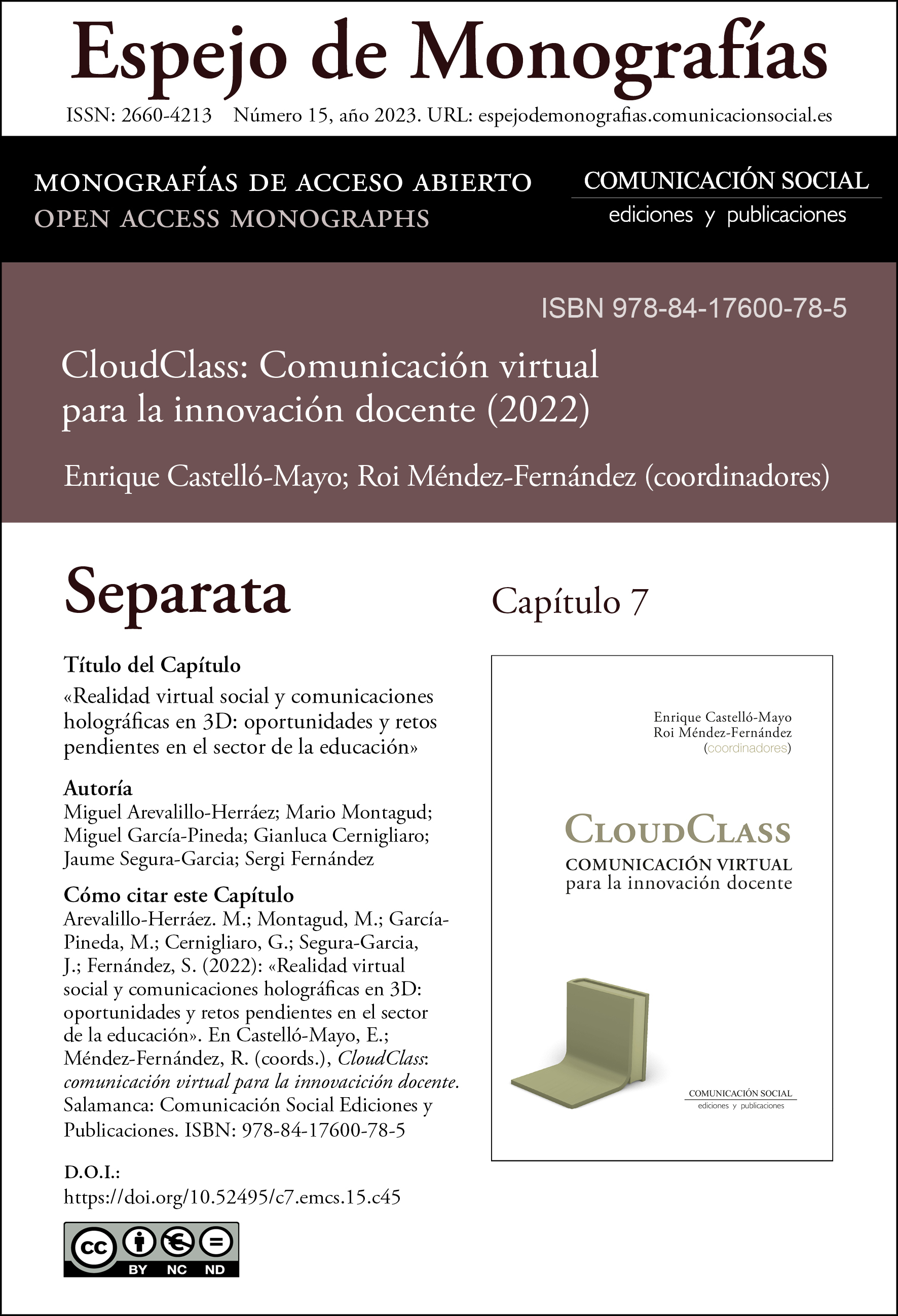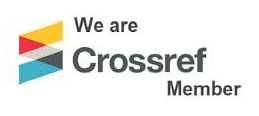Capítulo 7. Realidad virtual social y comunicaciones holográficas en 3D: oportunidades y retos pendientes en el sector de la educación
DOI:
https://doi.org/10.52495/c7.emcs.15.c45Palabras clave:
realidad virtual social, comunicaciones holográficas, metaverso, holoportación, educación inmersiva, educación virtualResumen
En los últimos años se está explorando el uso y adopción de tecnologías innovadoras en el sector de la educación y aprendizaje. Asimismo, modelos de educación y docencia online están ganando protagonismo, ya sea debido a una implantación voluntaria o forzosa de programas de educación remota y/o híbrida. Este auge ha hecho palpable las limitaciones de los sistemas de comunicaciones audiovisuales 2D, como la videoconferencia, en varios sentidos: confort, calidad de interacción, conciencia situacional, (co-)presencia, etc. Este trabajo introduce un nuevo medio de comunicación, interacción y colaboración que promete ser un candidato idóneo para superar estas limitaciones haciendo uso de tecnologías inmersivas: la Realidad Virtual (RV) Social. En primer lugar, se aportará una revisión de evidencias científicas recientes que vislumbran y demuestran potenciales beneficios de este medio para diferentes casos de uso de interés, en comparación al uso de sistemas de videoconferencia 2D tradicionales. Asimismo, se destacarán los potenciales beneficios que puede aportar la disponibilidad de representaciones holográficas 3D de los usuarios en comparación al uso de avatares sintéticos (y por tanto, poco realistas) en entornos de RV Social. A continuación, se destacarán una serie de retos a nivel tecnológico y de experiencia de usuario a superar con tal de conseguir una implantación efectiva y masiva de este nuevo medio de comunicación.
Descargas
Citas
Aguayo, C.; Eames, C.; Cochrane, T. (2020). «A framework for mixed reality free-choice, self-determined learning», Research in Learning Technology, 28, 1-19, 2020.
Berg, L.P.; Vance, J.M. (2017). «Industry use of virtual reality in product design and manufacturing: a survey», Virtual Reality, 21(1), 1-17, 2017.
Boronat, F.; Montagud, M.; Salvador, P.; Pastor, J. (2021). «Wersync: a web platform for synchronized social viewing enabling interaction and collaboration», Journal of Network and Computer Applications, Elsevier, vol. 175, Issue 1, pp. 1-21.
Campbell, A. et al. (2020). «Uses of Virtual Reality for Communication in Financial Services: A Case Study on Comparing Different Telepresence Interfaces: Virtual Reality Compared to Video Conferencing», In: K. Arai; R. Bhatia, R. (eds), Advances in Information and Communication, Proceedings of the 2019 Future of Information and Communication Conference (FICC), vol 69, pp. 463-481, Springer.
Carr, D.; Oliver, M.; Burn, A. (2010). «Learning, teaching and ambiguity in virtual worlds», In: A. Peachey, J. Gillen, D. Livingstone, S. Smith-Robbins (eds), Researching Learning in Virtual Worlds, Human-Computer Interaction Series. Springer, London.
Cernigliaro, G.; Martos, M.; Montagud, M.; Ansari, A.; Fernández, S. (2020). «PC-MCU: Point Cloud Multipoint Control Unit for Multi-user Holoconferencing Systems», ACM NOSSDAV 2020, Istanbul (Turkey), June 2020.
Chessa, M.; Solari, F. (2021). «The sense of being there during online classes: analysis of usability and presence in web-conferencing systems and virtual reality social platforms», Behaviour & Information Technology, 40:12, 1237-1249.
Fernández, S.; Montagud, M.; Cernigliaro, G.; Rincón, D. (2022a), «Multiparty Holomeetings: Toward a New Era of Low-Cost Volumetric Holographic Meetings in Virtual Reality», IEEE Access, vol. 10, pp. 81856-81876.
Fernández, S.; Montagud, M.; Cernigliaro, G.; Rincón, D. (2022b), «Toward Hyper-realistic and Interactive Social VR Experiences in Live TV Scenarios», IEEE Transactions on Broadcasting, vol. 68, no. 1, pp. 13-32.
Gregory S. et al. (2013). «Virtual worlds in Australian and new Zealand higher education: remembering the past, understanding the present and imagining the future», Electric Dreams, Eds H. Carte; M. Gosper; J. Hedberg (Sydney, NSW: Macquarie University), 312-324.
Gregory, S.; Jacka, L.; Hillier, M.; Grant, S. (2015). «Using virtual worlds in rural and regional educational institutions», Australian and International Journal of Rural Education, 25, 73-90 .
Gunkel, S. et al. (2021) «VRComm: an end-to-end web system for real-time photorealistic social VR communication», 12th ACM Multimedia Systems Conference (MMSys’21), Istanbul (Turkey), June 2021.
Hagler, J.; Lankes, M.; Gallist, N. (2022). «Behind the Curtains: Comparing Mozilla Hubs with Microsoft Teams in a Guided Virtual Theatre Experience», IEEE Conference on Virtual Reality and 3D User Interfaces Abstracts and Workshops (VRW) 2022, pp. 19-22
Heidicker, P.; Langbehn, E.; Steinicke, F. (2017). «Influence of avatar appearance on presence in Social VR», IEEE Symposium on 3D User Interfaces (3DUI) 2017, 233-234, Los Angeles (USA), March 2017.
Herder, J.; Brettschneider, N.; Mooij, J.D.; Ryskeldie, B. (2019). «Avatars for co-located collaborations in HMD- based virtual environments’», IEEE Conference on Virtual Reality and 3D User Interfaces (VR) 2019, 968- 969, Osaka (Japan), March 2019.
Jones, P. et al. (2022). «FOUR: Working with social VR», In Virtual Reality Methods, Bristol (UK), Policy Press.
Khojasteh, N.; Won, A.S. (2021). «Working Together on Diverse Tasks: A Longitudinal Study on Individual Workload, Presence and Emotional Recognition in Collaborative Virtual Environments», Frontiers in Virtual Reality, 2:643331
Latoschik, M.E. et al. (2017). «The effect of avatar realism in immersive social virtual realities», 23rd ACM Symposium on Virtual Reality Software and Technology (VRST’17), Gothenburg (Sweden).
Lee, C.; Joo, H.; Jun, S. (2021) «Social VR as the new normal? Understanding user interactions for the business arena». Extended Abstracts of the 2021 CHI Conference on Human Factors in Computing Systems, Article 420, Yokohama (Japan).
McGee, B.L.; Jacka, L. (2021). «Virtual reality in Education. Broken promises or new hope?», In S. Gregory; S. Warburton; M. Schier, M. (Eds.), Back to the Future–ASCILITE ’21, Proceedings ASCILITE 2021, pp. 74-80, Armidale (Australia).
Mei ,Y.; Li, J.; de Ridder, H.; Cesar, P. (2021). «CakeVR: A Social Virtual Reality (VR) Tool for Co-designing Cakes», ACM Conference on Human Factors in Computing Systems (CHI ‘21), Article 572, 1-14, Yokohama (Japan).
Montagud, M.; Orero, P.; Matamala, A. (2020). «Culture 4 All: Accessibility-Enabled Cultural Experiences through Immersive VR360 content», Personal and Ubiquitous Computing, Springer, 24, 887.905
Montagud, M.; Orero, P.; Fernández, S. (2020). «Immersive Media and Accessibility: Hand in Hand to the Future», ITU Journal: ICT Discoveries, Vol. 3(1).
Montagud, M.; Li, J.; Cernigliaro, G.; El Ali, A.; Fernández, S.; Cesar, P. (2022). «Towards socialVR: evaluating a novel technology for watching videos together», Virtual Reality (Springer).
Oberdörfer, S.; Heidrich, D.; Latoschik, M.E. (2019). «Usability of gamified knowledge learning in VR and desktop-3D», ACM Conference on Human Factors in Computing Systems 2019, CHI’19, 1-13, Glasgow (UK).
Radianti, J.; Majchrzak ,T.A.; Fromm, J.; Wohlgenannt, I. (2020). «A systematic review of immersive virtual reality applications for higher education: Design elements, lessons learned, and research agenda», Computers & Education, Vol. 147.
Roth, D. et al. (2016) «Avatar realism and social interaction quality in virtual reality», IEEE Virtual Reality (VR) 2016, 277-278, Greenville (South Carolina, USA).
Smith, H.J.; Neff, M. (2018). «Communication behavior in embodied Virtual Reality», ACM Conference on Human Factors in Computing Systems (CHI’18), Montreal (Canada.)
Steinicke, F.; Meinecke, A.; Lehmann-Willenbrock, N. (2020). «A first pilot study to compare virtual group meetings using video conferences and (immersive) virtual reality», ACM Symposium on Spatial User Interaction (SUI) 2020, Canada (Virtual Event).
Stone, V.E. (1993). «Social interaction and social development in virtual environments», Presence: Teleoperators and Virtual Environments, 2(2), 153- 161.
Yoshimura, A.; Borst, C.W. (2021). «A Study of Class Meetings» in VR: Student Experiences of Attending Lectures and of Giving a Project Presentation, Front. Virtual Real, 2:648619.

Publicado
Cómo citar
Número
Sección
Licencia

Esta obra está bajo una licencia internacional Creative Commons Atribución-NoComercial 4.0.
Los artículos publicados en la revista se distribuyen con la Licencia Creative Commons Atribución-NoComercial-SinDerivadas 4.0 Internacional










